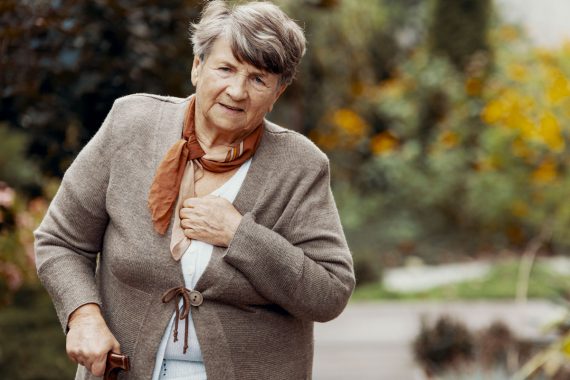Red flag refreshers: Breathlessness

Breathlessness is a common symptom and the pandemic has obviously led to heightened awareness.
Obesity or deconditioning should be diagnoses of exclusion.
Deciding which cases need evaluation can be challenging so be aware of the following factors.1
Time of onset
• Acute (minutes) – send to A&E. Potential causes:
– Pulmonary embolism (PE).
– Pneumothorax.
– Foreign body.
– Anaphylaxis.
– Anxiety.
• Subacute (hours) – send to A&E.
– Pulmonary oedema (LVF).
– Asthma.
– COPD.
– Chest infections (bacterial, TB, fungal, viral).
– Metabolic acidosis.
• Chronic (days to weeks) – refer to outpatient department (if not manageable in primary care):
– Anaemia.
– Recurrent PE.
– Cardiac disease (heart failure, arrhythmias, valvular heart disease, IHD).
– Asthma.
– COPD.
– Chest infections/bronchiectasis.
– Lung cancer.
– Pulmonary effusions.
– Idiopathic pulmonary fibrosis and other interstitial lung diseases.
– Pulmonary hypertension.
– Hepatorenal syndrome.
– Cirrhotic hydrothorax.
– Neuromuscular disorders, chest wall deformities.
– COVID-19 disease.
Red flags
The following red flags in the history should prompt investigation:
• New cough lasting over three weeks.
• Haemoptysis – possible infection (pneumonia, TB, PE) or lung cancer. (People born outside the UK accounted for 72% of TB notifications in 2018, and most have at least one other social risk factor.)2
• Fevers.
• Night sweats.
• Weight loss.
• Chest pain – could be angina.
Consider also the following aspects.
Smoking
• Ask about use of tobacco, cannabis, crack/cocaine and other illicit drugs. Cannabis smoking causes emphysema at a younger age than cigarette smoking alone and is linked with pneumothorax.3
• Almost three-quarters of lung cancer cases in the UK are caused by smoking.4
• Half of lifelong smokers develop COPD.5
Age
• Incidence rates for lung cancer in the UK are highest in people aged 85-89.4
• Most older asthmatics will have non-reversible airway obstruction.6
• Most people are at least 35 years old when symptoms of COPD first appear because of pack-year history.7
Environmental factors
• Asthma is the most common occupational lung disease. At-risk groups include animal handlers, chemical workers, timber workers, bakers and welders. Asthma can be exacerbated, but not caused, by work.
• Asbestos exposure increases the risk of lung cancer, mesothelioma and pulmonary fibrosis. Those involved in construction between the 1970s and 1990s are especially at risk.8
• Hypersensitivity pneumonitis, a rare cause of breathlessness, is caused by prolonged inhalation of dust or fumes, for example mouldy hay or barley, house dust, and metalworking fluid.
• Some 5% of lung cancer cases in the UK are caused by ionising radiation.
• Some 23% of lung cancer cases in the UK are caused by workplace exposures.
• Some 8% of lung cancer cases in the UK are caused by air pollution.4
• Eczema, allergic rhinitis and hay fever are associated with asthma.
• Family history is associated with asthma, cystic fibrosis and alpha-1-antitrypsin deficiency.7
Signs to look for on examination
• Finger clubbing.
• Lymphadenopathy.
• Superior vena cava syndrome (swelling, plethora and venous distension of the face, upper chest and arms).
Investigations
Before referring, ensure the following:
• A thorough history has excluded a non-pulmonary cause.
• Rule out a cardiac cause of the patient’s breathlessness by ordering both a BNP and an echo, and referring to cardiology if appropriate.
• If you suspect asthma, ask the patient to keep a peak flow diary (twice daily), and order a FeNO test.
• If you suspect malignancy, fibrosis or bronchiectasis, a CT chest is a reasonable investigation, especially if the patient is over 50 years old with a significant smoking history. Alternatively, make a two-week wait referral.9
• If you suspect pulmonary TB, the most useful tests are sputum MC&S, AFB and TB PCR.
What action needs to be taken?
Emergency
If the patient is acutely unwell, send immediately to A&E.
Urgent
Most cases of suspected TB, unless the patient is acutely unwell, can be referred to outpatients, though the patient must remain at home if coughing.
Routine
‘Brittle’ asthma needs a referral to prevent future morbidity and mortality. COPD, ILD or bronchiectasis do not need to be referred unless you are unsure of the diagnosis or the patient remains unwell despite your management.
Covid-19
Covid-19 may present as breathlessness. If you suspect Covid and the patient is well, advise to self-isolate at home for seven days. If they are unwell and might need oxygen, send them to hospital.
Dr Katharine Elliott is a respiratory registrar and Dr Himender Makker is a respiratory consultant at the North Middlesex Hospital
References
1 Sam A. Rapid differential diagnosis. Blackwell, 2003. P16
2 Public Health England. Tuberculosis in England: 2019. London, 2019.
3 Ruppert A, Perrin J, Khalil A et al. Effect of cannabis and tobacco on emphysema in patients with spontaneous pneumothorax. Diagn Interv Imaging 2018;99:465-71
4 About Cancer. cancerresearchuk.org/ lung cancer
5 Nuorti J, Butler J, Farley M et al. Cigarette Smoking and Invasive Pneumococcal Disease. N Engl J Med 2000; 342: 681–9
6 Respiratory Disease in Old Age: Research in Ageing Workshop. London, 1998. Age and Ageing 2000;29:281-5
7 NICE. Chronic obstructive pulmonary disease in over 16s: diagnosis and management. NG115 2018. nice.org.uk/guidance/ng115
8 Asbestosis. nhs.uk/asbestosis
9 NICE. Lung Cancer: Diagnosis and Management. NG122 2019. nice.org.uk/guidance/ng122
10 Coronavirus (Covid-19) nhs.uk/conditions/coronavirus-covid-19/
Visit Pulse Reference for details on 140 symptoms, including easily searchable symptoms and categories, offering you a free platform to check symptoms and receive potential diagnoses during consultations.









